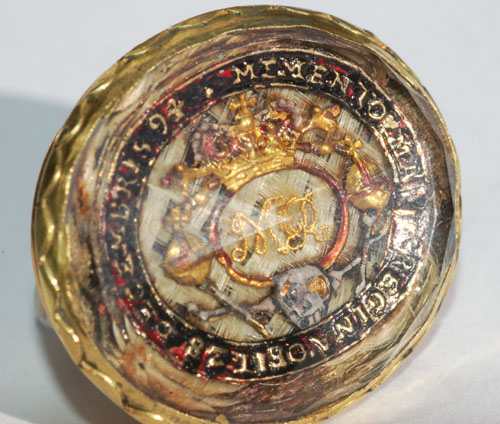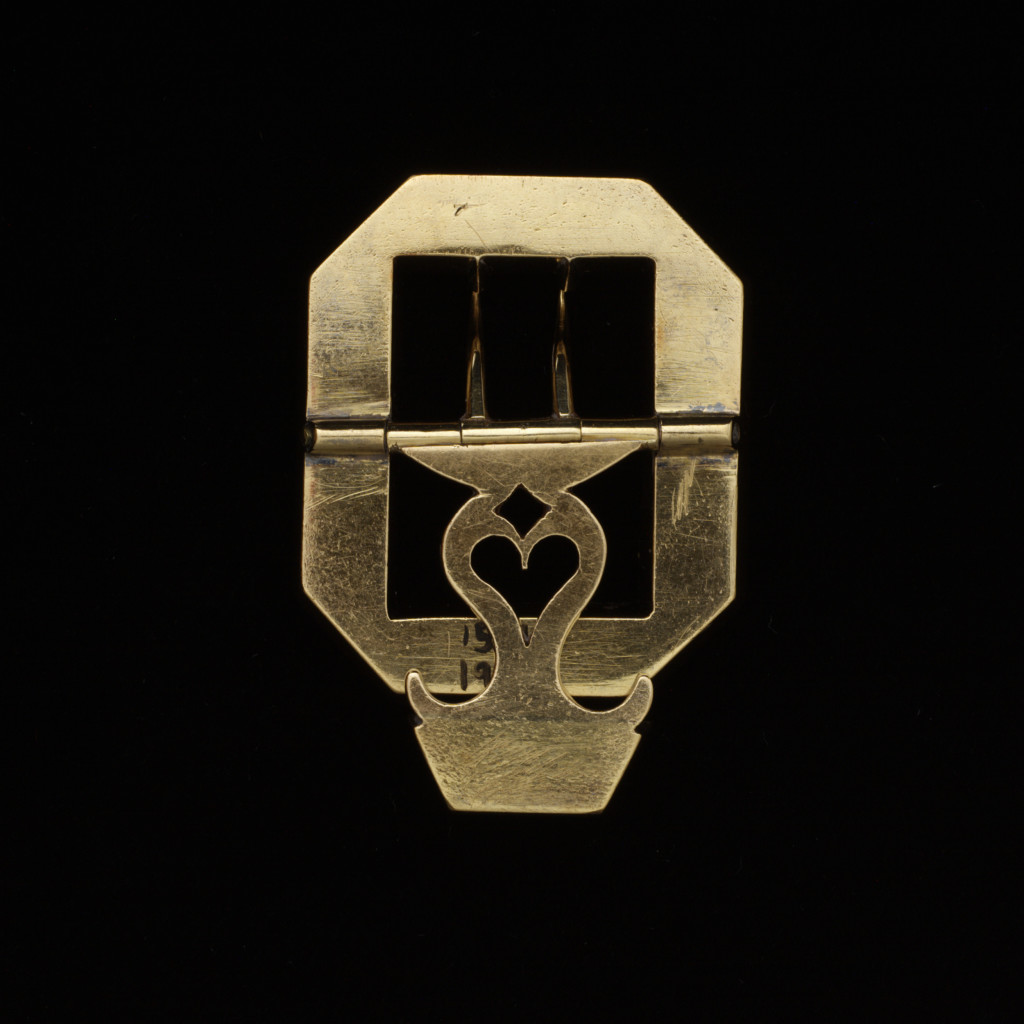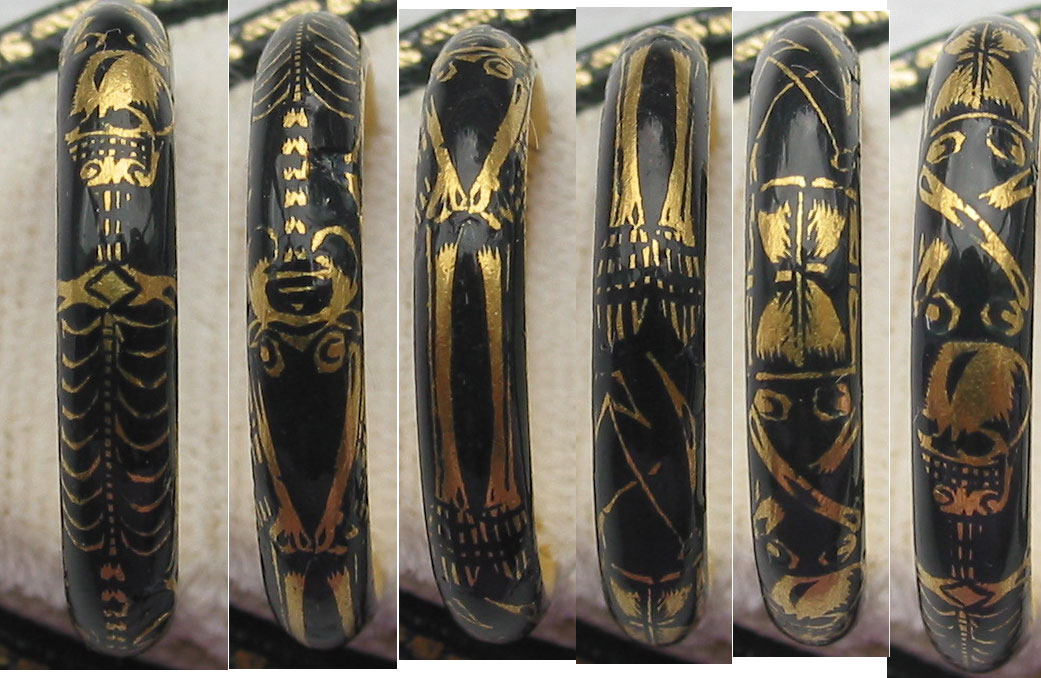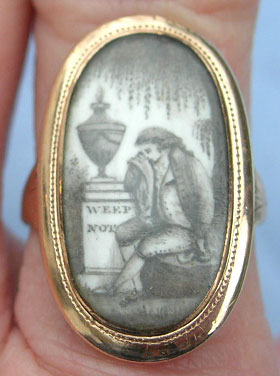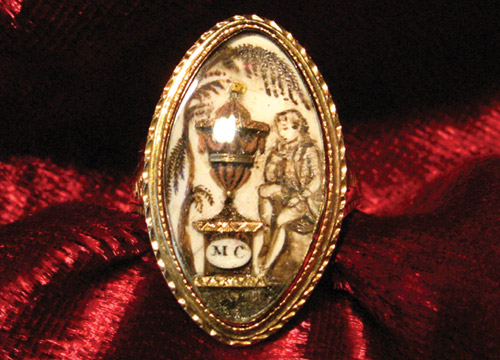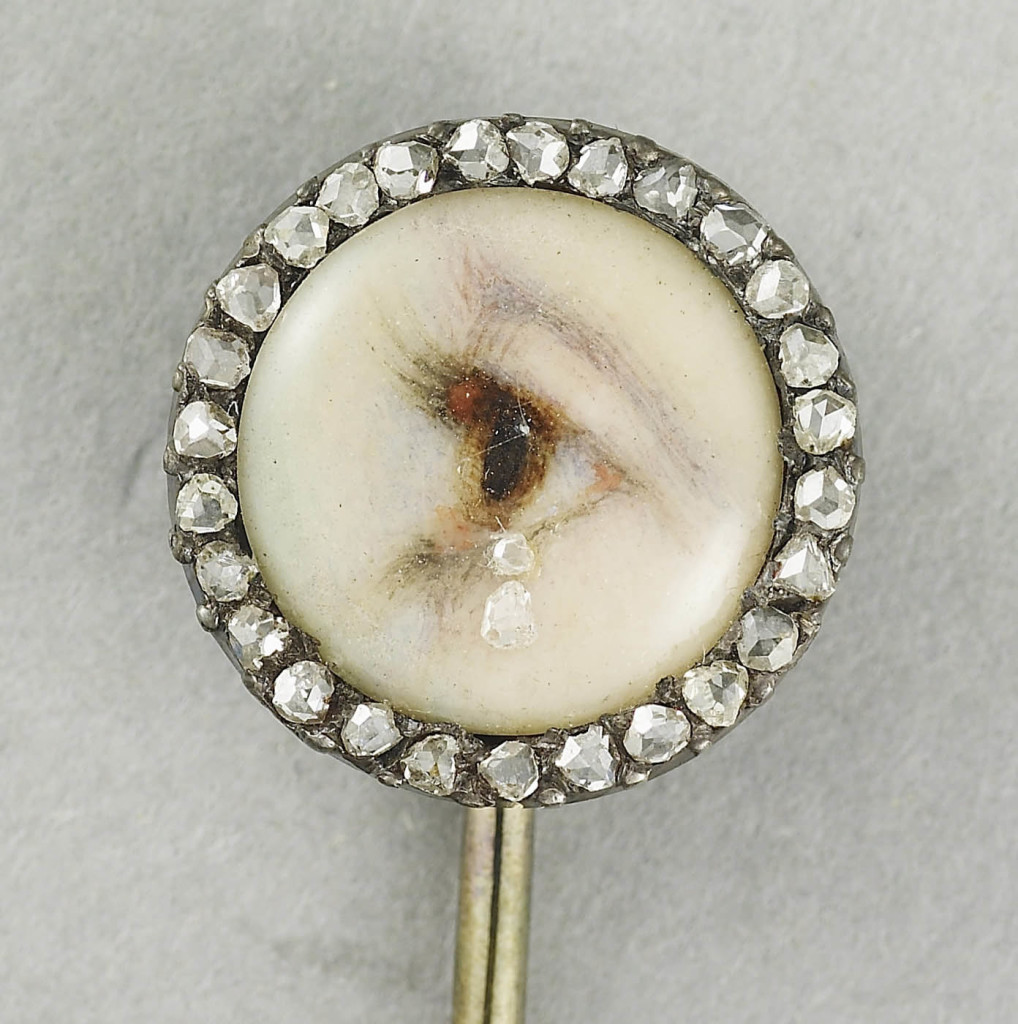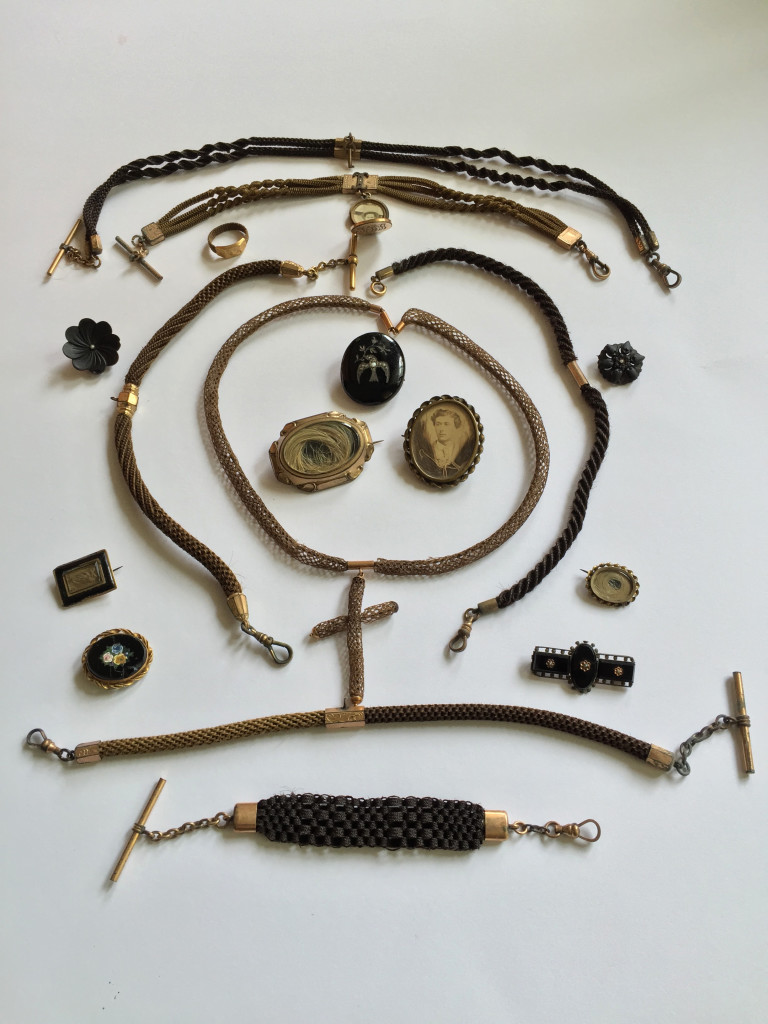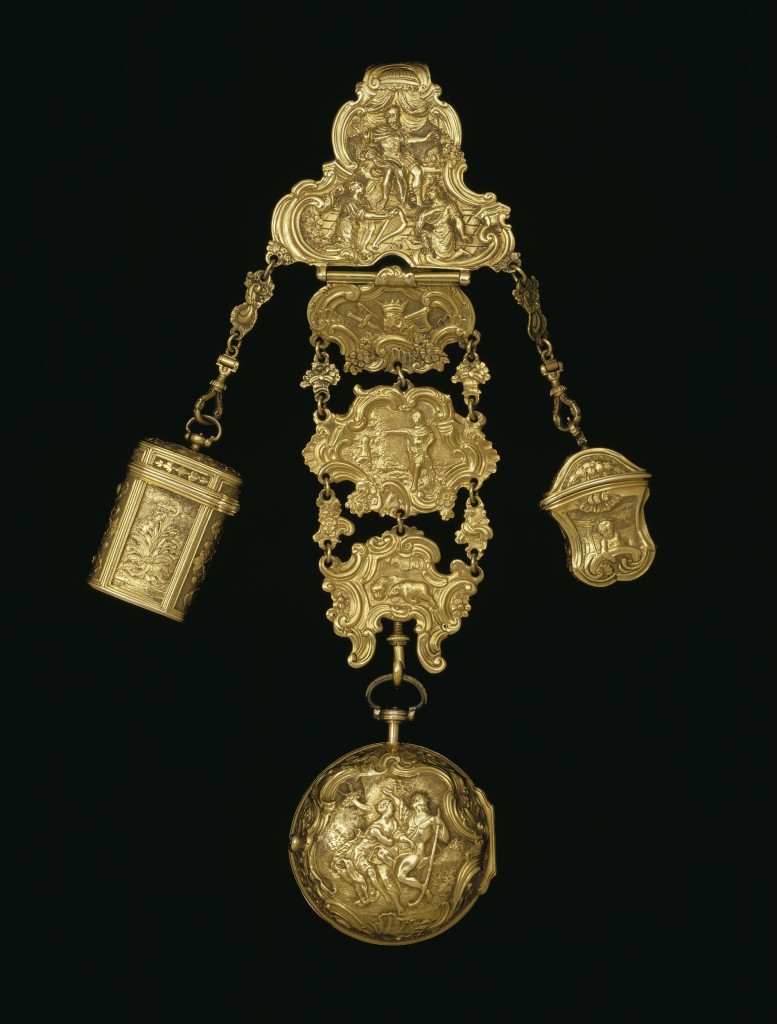Mourning Shoe Buckles and Fashion
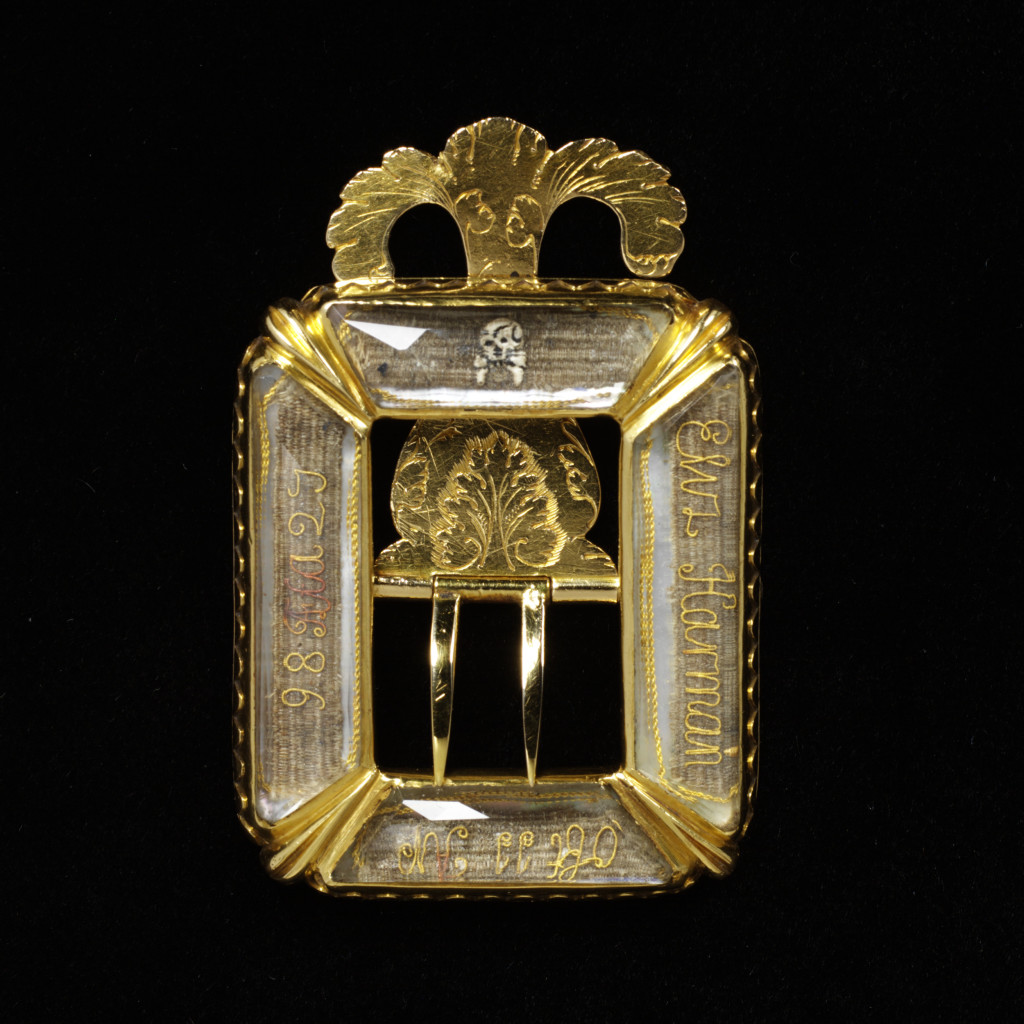
As with any piece of fashion accessory, if it could be introduced into the mourning industry, it would be. The industry that had grown as an autonomously driven entity from the 1680s had developed enough reason to exist through court edict that it was popular enough to cascade through society and be fashionable. When there was an area to be exploited, or an element of fashion that could be tailored to mourning, then the industry would quickly adapt and make it mourning related.
Shoe buckles are agnostic towards gender, but are commonly associated with men. Existing as a functional item previous to the early modern period, the focus of this article is the combination of a fashion accessory and the mourning industry. Popular from the mid 17h century and typically made of gold and silver, buckles were worn to replace laced shoes, but phased out in the turn of the 19th century. They have remained in use for ceremonial purposes, such as the Gentleman Usher of the Black Rod in Parliament, as part of traditional uniform. This has kept much of the 18th century costume still relevant in modernity, but is not a typical method of dress and hence, was not an accessory that remained appropriated by the mourning industry after the 18th century.
Due to their fashionability, shoe buckles were not just gold or silver, but also cut and polished steel (late 18th century), but inlaid with crystal, diamonds, paste and any materials with accessibility. As these accessories were viewed in light of court and high formal dress, their attention to detail does not spare any expense. In mourning, those who had shown their worth through their value of mourning valued their love higher than any other for the person who had been deceased. This is not genuine to the true emotion of death, but it is the unfortunate circumstance of society that wealth denotes status and in this case, love.
The first buckle on display is dedicated to the following:
Defining this buckle are its fleur-de-lis corners, faceted crystal (or “Stuart Crystal”) strips along the border, gold thread writing upon hair and the memento mori skull and crossbones at the loop. In order to investigate the style of a specific jewel, one must look to its contemporary jewels and see what popular designs appeared to be. In this case, we have a buckle of very high distinction, with no expense spared even to the etching of the gold itself. The buckle has kept in pristine condition, but if this buckle was worn at the foot, what was the style worn in other jewels?
A rare Stuart crystal slide to commemorate the death of Queen Mary II, joint sovereign of Britain from 1668 – 1694. Mary, the daughter of James II, was the wife of William of Orange, her first cousin. The marriage had been arranged for diplomatic reasons by Charles II yet produced no heirs. In December 1694 Mary succumbed to smallpox and died at the age of 32, on December 28th. Her husband was prostrate with grief and the nation underwent a period of long and deep mourning for the Queen. Four mournful trumpeters played a slow march leading her elaborate funeral procession to Westminster Abbey.
After his death, the King was found to have kept a lock of Mary’s hair and her wedding ring next to his heart. This commemorative slide for Mary is gold, set with a compartment of woven hair overlaid with devices of the royal crown and sceptre, two orbs and an enamelled skull and crossbones. The central gold cipher letters MR represent Mary Regina and around the edge of the slide in red and gold enamelled letters is the motto : Memento Maria Regina Obit 28 December 1694. The slide is covered with a densely faceted rock crystal. It measures one inch by 3/4 of an inch, with coloured enamels as they would have been in 1695.
Here is a fine comparison of jewels. The faceted crystal and close proximity of year show the basic similarities that were common in mourning jewels for the late 17th century. The slide, with its enamelled decoration, is part of memorial jewellery history in that it was a universal reaction by the community to mourning Queen Mary II, but the fine jewels to be worn in public were relegated to the aristocracy. Gold thread is used to create the initials in this slide, much the same as the buckle’s dedication, with the same stylistic approach to the skull and crossbones in enamel. It is important to note that the standardisation of mourning symbols began in the post 1680 period, as production had increased, social mobility meant that designs could travel further as people did, hence symbols needed equal representation in the eye of the viewer.
The period of 1690-1720 was one of standardisation and adaptation in mourning jewellery. As the industry grew, more goldsmiths and jewellers appeared to facilitate a population hungry for the affectation of mourning jewels. The use of faceted crystal had been popular for over thirty years, making it emblematic of its position in history, which is why it is often referred to as ‘Stuart Crystal’, connected with the Stuart era. The following buckle from 1725 displays this in exquisite detail:
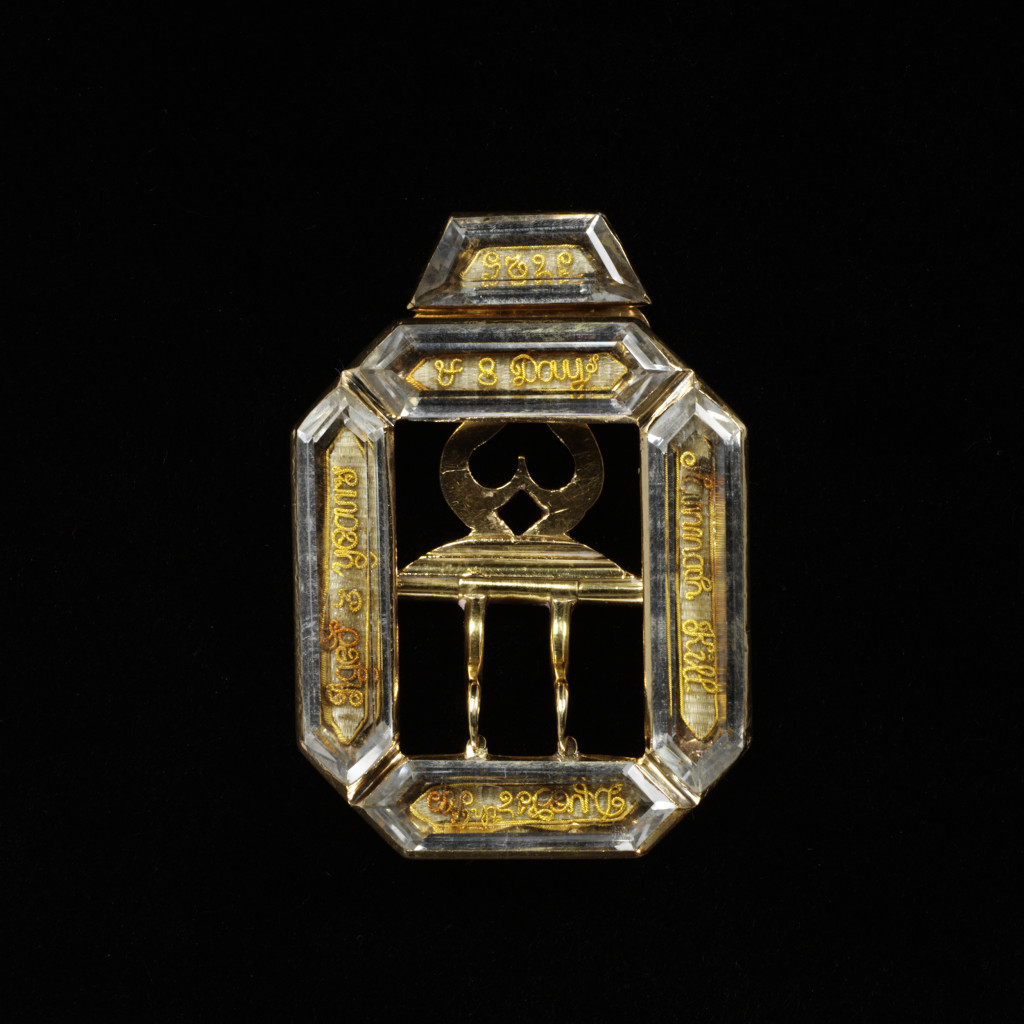
What is interesting to note about this buckle is that it was for a girl aged three years and eight days, which would put it into the realm of typical virginal mourning jewels that utilise white enamel. This does not, but it does have the bespoke gold thread writing across the hair, written in a very unique way. It it not a jewel that was made specifically for the death of the child, but a jewel that was customised to her passing. Unlike rings or slides, buckles are functional; keeping the shoe held together across the foot. There is no excess room for delicate design that could be harmed in a way of high usage (not that these shoes/buckles would be used for day to day service), but the use of materials is relevant to their actual usage. Metals, gems and crystal are typical for this, as they can sustain a higher degree of wear. Hannah’s buckle displays a faint skull motif in the latch, but its design is a clear continuity of what had come before, simply refined. The edging to the borders is still there, but the crystal is simpler in its cut and less refined.
As time went on, the evolution of the crystal style in memento mori jewels became smaller and more detailed. A jewel wit the skull and crossbones in the 17th century would be larger and painted in enamel, mostly taking over the bezel, but in the early 18th century, the symbols became much smaller and placed under the crystal.

In this buckle, there is less use of gold and more emphasis on negative space, along with the border of the buckle being most prominent. Crystal, being cheaper as a material than gold, creates the entire buckle and is clearly related to the previous Hannah buckle. Its use of the tight gold thread inscription and Rococo flourish displays the customisation we have previously seen, being tailored to the needs of the person who commissioned the buckle. Production had to have been in high quantity, without the assumption that each jewel for the post 1680 period being bespoke. Wealth can still produce individual jewels even today, but there needs to be a standard that a jeweller could sell. Predesigned jewels are part of modern production and if the jewel was chosen from a cabinet, master template or catalogue, the outcome needs a level of effort to have produced enough to satisfy a market.
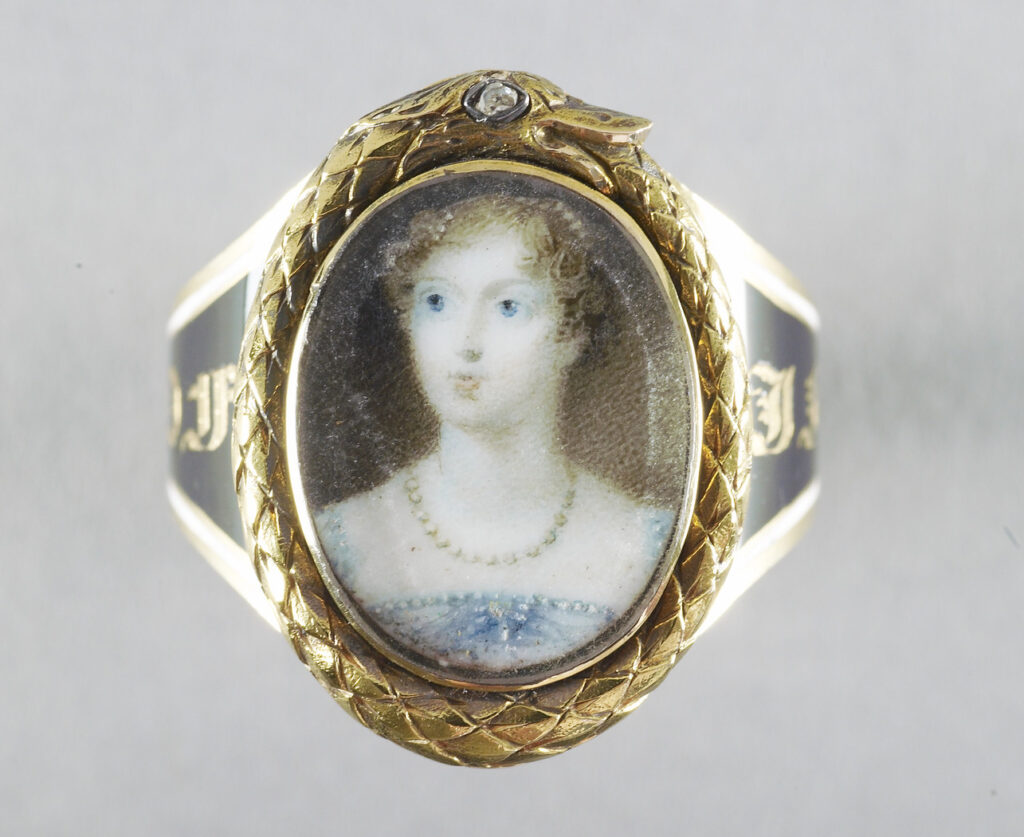
Having looked at these jewels, looking back towards a royal jewel is required to see their context in popularity. The following ring is elegant and simple enough in its design to have been worn for regular purposes after the death of Princess Charlotte Augusta in 1817. Many mourning jewels were created for her passing, being a time of public mourning that reflected back upon her husband, George II, and the British society.
When a member of the monarchy dies, there is expected public court-imposed mourning periods, however, there are monarchs which follow this and others which define it. Caroline, much like Princess Charlotte in 1817, defined this, as their zeitgeist captures the public imagination and leads towards a following that resonates. As can be seen by the plate above, the pieces that were created for Caroline were varied and opulent, creating new styles of mourning at a time when these elements were being defined.
Much of this is from her adherence towards Protestantism, a reason why she was courted by Archduke Charles of Austria (later Charles VI, Holy Roman Emperor), but refused to convert to Catholicism from Lutheranism. Her refusal was in 1704 and this ring was created in 1736, a period enough away from the English Restoration with enough opportunity to identify with a style for mourning and sentimentalism in jewellery which reflected the humanist approach to what the definition of love and life were. Caroline held onto her values and that spirit is reflected in her lifestyle and her death. One must look beyond the relationship between god and the self in her memorial pieces and see how it is her which identifies more with allegorical symbols of death, rather than the Catholic depictions of entering into heaven.
Indeed, the ring speaks to this. Despite being high in quality and quite a piece for its time, it still retain its human roots and is quite humble for a monarch to have their hair displayed. It doesn’t contain any diamonds or other gems, nor does it have depictions of the crown. This piece comes from a transition, where French styles were beginning to influence English mourning jewellery, particularly through the use of enamel.
Mourning jewellery in the 1730s carried on from many of the styles set in the 1680s, standardising the Baroque influence in jewels and refining down various elements to make themselves obvious for their time. Much of this is seen in the reduction of the Memento Mori symbols that had defined death through the 17th century, changing into simple, single mourning elements, rather than a combination of many. An example of this can be seen in the skeleton rings of the 18th century and their holistic take-over of a band. This gives one singular element the clear definition of the ring:
Similarly, the coffin ring from 1715 uses the one element of the coffin as only the crystal shape, with the skull placed above hairwork. The following ring shows a smaller simplification of the 17th century style, with the sparing elements of the skull and the coffin used:
17th century mourning jewels used the faceted crystal, which was popular for its ability to capture the light, very much like a diamond. Used often in slides, rings, bracelets and brooches, adorning the bodice, neck, wrists and fingers, the way to depict oneself in mourning was not a subtle one. The self was the carrier for the memory to project outwards and notify others about the memory of this person, as well as the status of the person in mourning.

This mourning buckle, dedicated to Queen Caroline, can be seen by its relation to other mourning peripherals, it has a humble element that could be forged and replicated to reach a large audience. In times of public mourning, fashion becomes standardised even further. This creates unity within a society and an identity with which people can rally behind. Mourning is the purist form of memory and love, meaning that its identity is the fastest and most essential to be taken in by a community.
Fashion and costume itself are primary sources for the rapid uptake of this mourning identity. Buckles are part of this intrinsically, as they were ceremonial and fashionable, so they needed the same adornment as any other jewel, within functional reason.

An industry could grow in a space where fashion allowed. The following comes from NMS on an article series about buckles:
“By the end of the 17th century a substantial buckle making industry had developed centred on Birmingham having been introduced there from Staffordshire in the 1680′s. By the latter half of the 18th century Birmingham was employing 4,000 people in the manufacture of buckles and turning out 2,500,000 pairs annually at an average cost of 2/6d (25p) per pair. Much of this output was due to the stamping machine invented by John Pickering in 1769 and subsequently improved by Richard Ford of Birmingham. Now buckle frames could be produced in large quantities by machine pressing from prepared dies.”
This generation of wealth and high production is astounding for its time, which clearly replaced ribbons as being the item to wear. Even Samuel Pepys mentions this in his diary:
“To church in the afternoon to Mr. Herring, where a lazy poor sermon. And so home with Mrs. Turner and sitting with her a while we went to my father’s where we supt very merry, and so home. This day I began to put on buckles to my shoes, which I have bought yesterday of Mr. Wotton.” – Diary of Samuel Pepys
As the 18th century welcomed in greater convention for mourning fashion the mourning industry had established itself as a viable and lucrative industry.. This became so much so that mourning dress was becoming desirable and the difference between mourning and non mourning dress was narrowing. Much of the fashion in this century was dictated by the fabric rather than the cut, and the silk industries in France and England held major influence on mourning wear because of this. It was Ordre Chronologique des Deuils de la Cour, (1765) where details of Court mourning in France were published, giving precise tailoring instructions. From their first days in mourning, men were permitted to appear in Court, unless it was after the death of a parent from whom they had received inheritance.
Standardisation of mourning fashion leads to the importance of this stickpin. Here, we have the male figure in repose next to the coffin on bier, which is important to note as it is pre-burial and not involving the Neoclassical urn, which would not simply denote cremation, but be a relevant allusion to the life itself.
This jewel is far more personal and immediate. It is a jewel which was painted hurriedly to capture a moment and not falling into the sepia painted, standardised jewels that relate more to the female mourning character in costume with the urn. The gentleman in his single breasted coat, powdered wig, long waistcoat, tied white neckcloth, white breeches, wrist frills and buckled shoes typifies the style of court or evening wear, which represents the ceremony of the moment. Male costume in the 18th century still retains the conventions of the 17th century, but adapts closer to popular fashion of the time.
Mourning suits were cut to the same style as their daily clothes. By mid century, coat skirts became flared with the addition of pleats in the back and side seams and by the 1770s, slimmer lines were once again fashionable. Black woolen cloth was acceptable for first mourning, where French etiquette was followed. In Second mourning, black suits and stockings were permitted and grey was allowed. The trains of black mourning cloaks were graded as per the rank of the wearer (Chief Mourners or otherwise), black hats were knotted with hatbands in black or white, which varied for status. Hatbands fell down the wearer’s backs shoulder scarves or sashes were worn at funerals by the less important and men and women wore white accessories at the burial of a woman or child. Crape, silk and to a lesser degree, satin were also used. It was around this time that the armband, a staple in men’s mourning fashion came into use and remains even today.
Convention carried through from the 17th century was starting to lose its prominence in male costume, mourning would be carried over through the 19th century by women and the armband would be the symbolic mourning device used by men. For men, the rule for First Court Mourning was black woolen suits, without fashionable buttons on sleeves or pockets. Muslin or lawn cravats, rather than shirt frills were common and lace cuffs replaced ‘weepers’. Crape hatbands, woolen stockings, shammy shoes, gloves, black (mourning) swords and shoe buckles were proper accessories. Fringed linen was permitted for Second mourning.
Throughout the social change that allowed this greater permission of mourning, there was a tremendous strain on tailors to provide mourning costume on a large scale. Culturally, there was a large amount of friction between the lower middle and upper classes, as there was no precedence for inter-class mixing. Changing art styles and the emergence of mass print and communications and greater dissemination of wealth would lead to the absolute peak of the industry in the 19th century.
With all this change and adaptation of style from the 17th to the 19th centuries, the buckle reached its height and disappeared, but utilised all the elements of fashion that would make them perfect for displaying mourning in public. Their creation as an assistance to a person in mourning provided a memory for them every time they looked at their feet.





